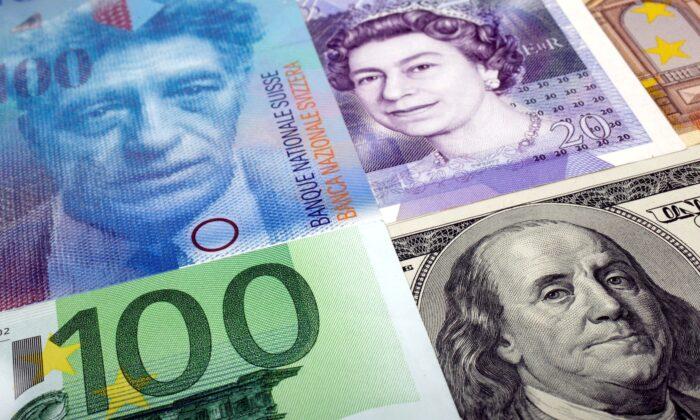LONDON—The euro and the yen rose on Thursday, reversing some of their recent losses against the U.S. dollar, while the Swiss franc hit a one-month high against the euro after Swiss inflation soared to its highest in 14-years.
The dollar had risen to a three-week high versus the Japanese yen and rallied versus the euro after an overnight advance in Treasury yields. But by the European open momentum in the U.S. currency had fizzled along with a fall in U.S. yields. Trading on Thursday is quieter with London markets shut for a UK holiday.
By 1115 GMT, the dollar was down 0.4 percent against a basket of other major currencies, while the euro climbed 0.4 percent to as high as $1.0696, following two days of losses. The yen erased its early weakness and was last at 129.74 yen per dollar, up on the day.
Data this week, stronger than expected in the United States, has reaffirmed that the U.S. economy is likely to hold up better than rivals even as the global economy slows.
“Robust U.S. data and an ensuing extinguishing of hopes that the Fed would need to ease hiking expectations were behind the U.S. Dollar rally,” said Jeffrey Halley, an analyst at OANDA, describing this week’s European economic data by contrast as “soggy.”
But a record eurozone inflation reading this week adds to pressure on the European Central Bank, which meets next week to discuss policy, to act to tame price growth even if that means weakening a slowing economy.
The Swiss franc gained 0.3 percent to 1.022 francs per euro, a one-month high, after Swiss prices increased by their highest level in 14 years during May. But it later gave up gains to trade flat at 1.0263
The 2.9 percent reading may look modest versus the 8 percent-plus numbers in the eurozone and Britain, but Switzerland is known as a country with historically low inflation so it will further pressure the Swiss National Bank (SNB) to address rising prices.
The franc had broken parity with the euro in March as traders bet the ultra-dovish SNB would be forced to tighten and less inclined to fight a strengthening franc.
Another Rate Hike
The Canadian dollar was little changed at C$1.2646 after the Bank of Canada on Wednesday, as expected, hiked rates by 50 basis points and signaled more aggressive tightening to come.Australia’s dollar rallied 0.3 percent and sterling 0.6 percent, both helped by improved investor sentiment across asset classes.
Despite Thursday’s fall, many analysts still see the U.S. dollar outperforming, especially if economic data supports a further rebound in U.S. Treasury yields.
The U.S. currency’s rally overnight was led by the U.S. 10-year yield hitting a two-week high of 2.951 percent on Wednesday, after data showed U.S. manufacturing activity had picked up in May as demand for goods remained strong.
Traders are now looking to more U.S. employment data due later Thursday and to Friday’s U.S. payroll numbers.






Friends Read Free